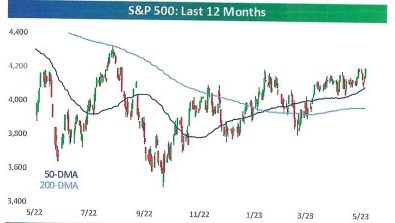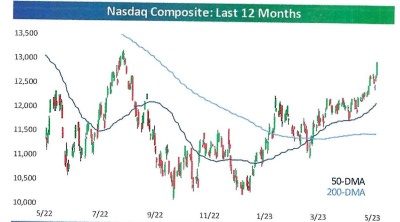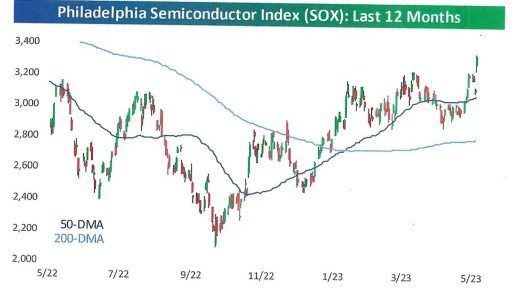We mentioned in our May commentary that the main theme for the next bull market could very well be Artificial Intelligence (AI). Although fundamentals and valuation metrics lead us to believe we are not yet in a new bull market, no one has told investors in AI stocks. Many AI stocks have soared in the last month, and some have gone parabolic. Direct AI stocks and those companies that use AI could be market leaders in the future, in our opinion. So it is imperative that we participate in this group. Even though some AI stocks are way ahead of themselves from a price perspective, we will be patient and add more key AI stocks if prices correct. Our current equity portfolio allocation to stocks that will directly benefit from AI is 12-15%, and we expect that percentage to go up over time.
We have been telling clients in meetings or on phone calls for the last six months that we are getting portfolios ready for the next bull market. What does that mean? How do you prepare for the next bull market? Here is a summary of what we are doing in client equity portfolios:
– First, we are adding exposure to the more cyclical sectors, which includes financials, consumer discretionary, technology, and industrials. Industrials don’t typically move until about halfway through a recession, but now is the time to buy them because of extremely low valuations, in our view. Technology and consumer discretionary stocks have already been moving up. Financials are also cyclical, especially banks. We tend to own money-center banks, not regionals, because of their relative operating stability. We find financial services stocks also attractive.
– Second, economic sectors less cyclical are being deemphasized. That includes consumer defensives, utilities and health care stocks. Health care stocks are a diverse group because some stocks in the sector are defensive (for example, pharmaceuticals) and some offensive (biotech).
Because we have long holding periods for stocks, there is a limit as to how much we can or actually do. We don’t like portfolio turnover. So our changes are made at the margin.
TECHNICAL ANALYSIS OF THE STOCK MARKET IS
BULLISH BUT FUNDAMENTAL AND VALUATION CONCERNS REMAIN
Bears can’t deny that the technical aspects of the market are improving. The worse enemy of a bear market is time. After making a low, the longer the index goes without making another one, the more likely it is that the bear market has ended. In the past when the S&P 500 declined 20%+ from a 52-week high (last year) and then went at least seven months without breaching that low (October 2022), performance over the following one, three, six, and 12 months has been much better than average and more consistent to the upside.
Also, both the S&P 500 and NASDAQ have broken above both their 50 and 200 day moving averages as shown in the graphs below. Often stocks have more room to run after the moving averages are no longer resistance to higher prices.


Source: Bespoke Investment Group
Next, semiconductor stocks, a leading indicator of the market, have regained strength. The Philadelphia Semiconductor-Index (SOX) relative strength versus the S&P 500 has gone parabolic and is back near new highs as shown below. Much of this is due to the surge in AI stocks, as many semiconductor stocks are seen as the “picks and shovels” of AI used by more and more companies.

Source: Bespoke Investment Group
Breadth (advancing stocks compared to declining stocks) is improving. Mega-caps are still leading the charge, but more and more stocks have been participating in the market advance.
Sentiment is improving but still decidedly bearish. There is plenty of room for investors to become more bullish and push prices higher.
Before we appear to be too bullish, we are reminded that the market still has fundamental and valuation challenges. We are still confronted with a tight Fed and a still probable recession in this year’s second half. And valuations are now at 19x forward S&P 500 earnings. How can a new bull market start from such a high P/E level? Earnings would have to soar in 2024 and beyond.
